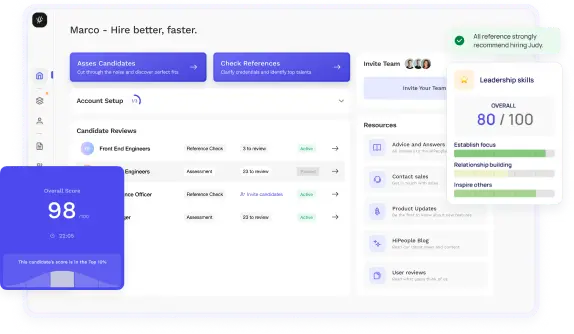
Streamline hiring with effortless screening tools
Optimise your hiring process with HiPeople's AI assessments and reference checks.

In August 2021, we spoke with Monique Major, Head of People & Culture at Vault Platform, the workplace misconduct reporting platform. Monique shared her thoughts on effective hiring, namely role design, requirements and the interview process.
Monique’s insights originally appeared alongside those of 11 other talent acquisition experts in our eBook, Reimagining Recruitment. You can download your own copy of our 50-page guide for free here.
Here are our three favorite things we learned from our conversation with Monique:
“For me, when I’m writing job descriptions, I’m acting as a storyteller sharing what is it like to be at the company and in that role. That means deeply understanding the role, and how it fits in the team and wider. By working with the hiring manager and team to focus on these pieces, you’ll be able to share what’s genuinely needed without arbitrary or superfluous extras, like education requirements.
“A lot of people fall into the trap of adding in degrees because it's easy to assume those courses encompass all the skills needed — and often that’s not the case”
“I think there are very few roles, particularly in tech, where that education piece is a hard requirement. A lot of people fall into the trap of adding in degrees because it's easy to assume those courses encompass all the skills needed — and often that’s not the case. Instead, we're looking for specific experience that may have just been a small subset of learning from a degree or learnt elsewhere.
“Sometimes it's also hard to know what experience is needed, especially if it's the first person you're hiring into that role. But, this is avoidable when you go beyond the surface and dive into what exactly do we expect people to do and deliver on. What skills can they take from other areas or other roles that they can bring into the role that we need? Asking those questions takes time — but it’s necessary.”
“If I’m getting feedback like ‘I just don’t think they’d be able to do the job’ or ‘I don’t feel they’d be able to handle the pressure’, I push back — that means nothing to me.
“If I’m noticing a pattern... I can see if that data is telling me a story”
“I'm looking for well-rounded feedback. I want to understand the examples and behaviours that made the interviewer come to an assessment, good or bad. The training and feedback forms I design encourage this — and when I don’t see this I'll follow up in a debrief or one-on-one.
“If I’m noticing a pattern with a particular interviewer — maybe they’re always rating candidates with particularly low scores — I can see if that data is telling me a story, and work with the interviewer to figure out what it is. Perhaps it’s something they’re not aware of, or perhaps it’s something we haven’t considered in the process that we need to ask better? It might be that there’s something really core to the role that we didn’t know about — in which case, let’s change it.”
“I don't want to have to put a candidate through something that just feels like a tick box exercise. We need to know what we're assessing for, and why we're assessing for it.
“I believe the more we share throughout the process, the better end decisions we'll make on both sides.”
“The interview process we design should be an extension of the work we've done building out the job description and defining what it is we’re looking for. I'm designing each stage in a way that embeds our values and helps us uncover if this candidate can deliver in those areas.
“I’m a big fan of transparency as much as possible. I share as early as possible or upfront what to expect from the interview process and how to prepare and include other elements like the measures of success for a role. I believe the more we share throughout the process, the better end decisions we'll make on both sides.”
Get more expert opinions on the future of recruiting in our free eBook.
Contact us to book a demo with a HiPeople expert. Learn how you can automate reference checks to reduce mis-hiring and reduce time-to-hire.